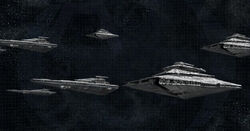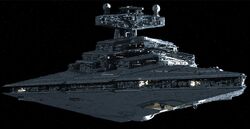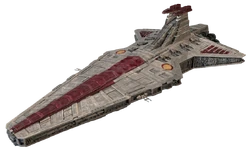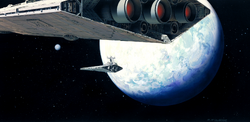| | |

An Imperial II-class Star Destroyer, second generation of the Galactic Empire's signature vessel
- "At that close range, we won't last long against those Star Destroyers!"
- ―Admiral Ackbar, during the Battle of Endor
Star Destroyer was a term used to describe a certain type of medium-sized[2] capital ship[3] used by various factions such as the Sith Empire, the Galactic Republic, the Galactic Empire, the New Republic, the Imperial Remnant, the Galactic Federation of Free Alliances, the Alliance-in-exile, the Fel Empire, Darth Krayt's Galactic Empire and the Galactic Federation Triumvirate. It was also used to describe heavily armed warships in general.[4]
The term originated with the idea of a warship powerful enough to destroy entire star systems, and did not necessarily indicate a destroyer type vessel.[4] Despite this, Star Destroyers were sometimes referred to as destroyers themselves. One such Star Destroyer was the Venator-class Star Destroyer of the Galactic Republic. In the Anaxes War College System, any warship that was between 1 and 2 kilometers in length qualifies as a Star Destroyer, excepting cases where the vessel, despite its length matching that of a heavy cruiser or battlecruiser, had less or more armaments than their class or role. Examples include the 900m Victory-series of Star Destroyer and the 2.2km Secutor-class Star Destroyer. Ships with a dagger profile that fall into the Battlecruiser or Dreadnaught classes are referred to as Super Star Destroyers.
Characteristics[]

While not technically Star Destroyers, ships like the Imperial II-class frigate, the Immobilizer 418 cruiser or the Victory II-class frigate possessed the typical characteristic of such vessels - a wedge shaped hull and command tower.
The term originated within the Old Republic and referred to ships capable of destroying entire star systems with their heavy firepower. The dagger-shape was said to facilitate the ease of this by focusing the firepower forward. Any vessel that conformed to this design, could be considered a class of Star Destroyer.[4] Even so, many models were designed with their heavy guns aimed to the sides of the vessel, obstructing each other's line-of-sight in other directions.[5]
In stricter terms, Star Destroyers were the relatively common warships that dwarfed the frigates and cruisers of one of the Galactic Empire's standard warship scales,[6][5] and were smaller than Imperial Star Cruisers.[3] Based on descriptions of the Star Dreadnought Executor, the Imperial Star Destroyer/Star Cruiser cut-off point lay somewhere around a length of 3.8 kilometers.[7] Destroyers could usually carry 10,000 or more people aboard it.
During the Clone Wars, Star Destroyers were considered medium-weight warships.[2] With the increase in warship-sizes during the time of the Empire, Star Destroyers were sometimes denoted as smaller vessels in the Imperial Navy.[8] In combat, Star Destroyers usually surpassed contemporary destroyer designs, similar to how the star frigates eclipsed most contemporary frigate classes.[2] The Star Destroyer designation was usually used for warships ranging from about 500 meters[9][10] to about 3.8 kilometers in length,[7][11][12] but the general term was used for much larger vessels as well.[13]
After the formation of the Anaxes War College System during the early stages of the Galactic Empire, Star Destroyers were classified as generally being between 1000 to 2000 meters in length. However, if the ship in question has fewer weapons than its standard class and the ship is larger (eg, the 2,200 meter Secutor-class Star Destroyer), that ship will be classified as a Star Destroyer.[14]
In the time of the second Galactic Empire, Star Destroyers were described as some of the largest and most powerful warships of the time, taking some design-cues from Star Dreadnoughts like the Executor-class[4] and performing the roles of large battleships despite their compact frame.[15] Many Star Destroyer classes throughout the various eras doubled as carriers.[2] In these cases, they often contained one or several wings of starfighters.[5][2]
History[]
Early designs[]

A Republic Sienar Systems Interdictor-class cruiser circa 3956 BBY.

A fleet of Harrower-class dreadnoughts circa 3681 BBY.
The use of wedge-shaped warships seems to be an ancient trend, dating as far back as over four millennia before the rise of the Galactic Empire. The designs were not limited to any one culture, having been observed frequently in both Galactic Republic[16] and Sith Empire navies.[17][18]
During the Mandalorian Wars 3,963 years before the Battle of Yavin, a Venator-like warship was used by the fleets of the Mandalorian Neo-Crusaders.[19] During the same conflicts, the wedge-shaped Interdictor-class cruiser and the Centurion-class battlecruiser were employed by Galactic Republic and later served in the navy of the Sith Empire established by Darth Revan.[18][16] Examples of these ships included the Leviathan[18] and the Ravager.[20]
The first design explicitly referred to as a "Star Destroyer", was the Harrower-class dreadnought of the resurgent Sith Empire. This design originated with Grand Moff Odile Vaiken as part of the Empire's military build-up in the 1,300 years that preceded the Great Galactic War.[17] These ships eventually fought in this 28-year long conflict against the Republic.[21]
Clone Wars-developments[]

The Acclamator-class assault ship circa 22 BBY, was a proto Star-Destroyer.
Star Destroyers that bore the distinctive wedge-shape, which came to be associated with the ship type, were in the service of the later Republic Navy around the time of the Clone Wars. The two most famous designs at the time were the Victory I- and Venator-classes, which were considered massive. Other Republic Star Destroyers, like the Imperator- and Tector-classes, became infamous for their service in the Imperial Navy.[2] The new Star Destroyer designs were born from the success of the Acclamator-class assault ship.[22][2] In addition, then-Supreme Chancellor of the Republic and future Galactic Emperor Palpatine mentioned in his Sith compendium, the Book of Sith, that the Star Destroyers developed during this time also shared similarities with the Harrower-class dreadnought.[23]
Imperial and New Republic usage[]
During the time of the Empire, many smaller and less independent dagger-shaped ships, such as the Immobilizer 418 cruiser[24] and the Broadside-class cruiser,[10] were often compared to small Star Destroyers without being classified as one themselves. In the Broadside's case, it was downgraded from 'Star Destroyer' to 'cruiser', due to its lack of defensive power and mobility.[10] In large part because of a Star Destroyer's capabilities, Mon Mothma, the leader of the Rebel Alliance, noted that if the Empire fragmented after Endor, it would pose the risk of any Imperial commander with access to a Star Destroyer becoming a warlord.[25]
While Star Destroyers served as the heaviest combatants in many fleets composed of frigates and down-scaled cruisers,[2] they performed an escort role when in the presence of specialized battleships found in the Republic Navy,[2] or larger Imperial warships such as the Executor-class.[26] Both the Republic[2] and the Empire maintained a higher-tier system of vessels heavier and more powerful than Star Destroyers, categorized from Battlecruisers to Star Dreadnoughts.[14] Building on the popularity the Star Destroyers gained in the Clone Wars, and the name of the "Super-class Star Destroyer,"[27] many of these heavy vessels were referred to in military colloquialism as "Super Star Destroyers" (sometimes omitting the "Super" prefix).[3] The Imperial Navy had around 25,000 ISDs alone throughout its existence.[28]
The New Republic also used the dagger-shape in their later Star Destroyer designs. However, not all vessels known as Star Destroyers adhered to the dagger aesthetic.[29]

Three Pellaeon-class Star Destroyers circa 137 ABY.
Notable Star Destroyer-manufacturers through the ages included Kuat Drive Yards,[2][3][30] Rendili StarDrive,[31][29] and the Republic Engineering Corporation.[29]
Later iterations[]
Even though the Galactic Alliance continued to use and produce Star Destroyers, they later decided to name their new ships "battle carriers" in order to avoid reminding people of the old Imperial terror symbols.[32] By the time of the Sith–Imperial War, the resurgent Empire utilized the Pellaeon-class Star Destroyer, which was described as one of the largest and most powerful warships of its time,[4] with unparallelled weapons-systems.[15] The Sith Empire led by Darth Krayt later constructed the much bigger and heavily armed Imperious-class Star Destroyer, the Imperious, which was stolen by the Galactic Alliance Remnant led by Gar Stazi when it became operational.[33]
Known designs[]
Aggressor-class Star Destroyer[]

The Aggressor-class
The Aggressor-class Star Destroyer was an experimental design, whose plans and prototype vessel were stolen by the Zann Consortium and modified. The Aggressor-class vessels went on to serve as one of the Consortium's most powerful capital ships.
Bakura-class destroyer[]

The Bakura-class
The Bakura-class Star Destroyer was created by Bakura after the Invasion of Bakura in 4 ABY. It was built around an Imperial II-class Star Destroyer's annihilation reactor and was 850 meters long. Three destroyers participated in the Battle of Centerpoint Station in 18 ABY.
Chiss Star Destroyer[]
Chiss Star Destroyers were needle-shaped warships 1,000 meters long, built by the Chiss and armed with masers. They participated in the Swarm War against the Killiks in 36 ABY. The Empire of the Hand utilized Chiss Star Destroyers in the Battle over Exodo II in 44 ABY.
Gladiator-class Star Destroyer[]

The Gladiator-class
The Gladiator-class was a small Star Destroyer class used by the Galactic Empire to subjugate outlying systems and enforce order on Outer Rim worlds not justifying the need for larger vessels. It was 600 meters long, and had a large hangar area towards the front of the vessel, with a hangar bay opening at the bow.
Imperial-class Star Destroyer[]
The Imperial-class consisted of several Star Destroyer models built by Kuat Drive Yards over several decades.
Imperator/Imperial I-class Star Destroyer[]

An Imperial-class Star Destroyer.
The 1,600-meter-long Imperator-class was created early in the Clone Wars, but only saw widespread deployment after the rise of the Galactic Empire. Following the Great Jedi Purge, the class was renamed to Imperial, but the original name was used in some official documents. It came to symbolize the tyranny of Imperial rule and was used throughout the galaxy for many decades, even long after the fall of the Empire and the establishment of both the New Republic and later the Galactic Alliance, who appropriated many vessels and used them in their own navies.
Imperator II/Imperial II-class Star Destroyer[]

The Imperial II-class
The Imperial II-class was fielded years after the first model, with some cosmetic differences. It became the norm for the Imperial Navy, with some Imperial Is retrofitted to be more similar to the second generation.
Imperious-class Star Destroyer[]

The Imperious-class
The Imperious-class Star Destroyer Imperious was built by the Mon Calamari Shipyards for Darth Krayt's Galactic Empire. It was later stolen by the Galactic Alliance Remnant upon completion and turned into their flagship.
Interdictor-class Star Destroyer[]

Some Star Destroyers possessed gravity-well projectors, capable of inhibiting hyperspace travel, such as the Interdictor-class.
The 1,600-meter-long Interdictor-class Star Destroyer comprised several designs of Star Destroyers fitted with gravity well projectors based on the ones from the smaller Immobilizer 418 cruiser.
Nebula/Defender-class Star Destroyer[]

The high cost of the Nebula-class Star Destroyer meant few ships were built.
The Nebula-class, also known as Defender-class, was a class of expensive and powerful warships. They were only 1,040 meters long, but their firepower was strong enough to dominate any known Star Destroyer class at the time and could take on some Super Star Destroyers as well. While smaller than other Destroyers they were packed with armament, at the expense of crew endurance. Because of their power requirements, they were very expensive and had a relatively small production run. Despite this, they performed well as core fleets during the Yuuzhan Vong War.
Pellaeon-class Star Destroyer[]

Like the Interdictor-class cruiser, Harrower-class dreadnought, Venator-class Star Destroyer and Imperial-class Star Destroyer before it, the Pellaeon-class Star Destroyer was the mainstay capital ship of its era. It was fielded over 100 years after the destruction of the Death Star.
The Pellaeon-class was built over 100 years after the Battle of Endor and the beginning of the downfall of the first Galactic Empire. It was made by KDY for the Fel Empire, and was based on the Imperial-class and also incorporated some elements of the Executor-class Star Dreadnought. It later served as the signature vessel of Darth Krayt's Empire.
Procursator[]

The 1,200 meter Procursator-class
The Procursator-class was a class used by the Galactic Empire and the New Republic.
Providence-class carrier/destroyer[]
The Providence-class carrier/destroyer was a capital ship design used during the Clone Wars by the Confederacy of Independent Systems. Some were identified under the name Separatist Star Destroyers.
Rejuvenator-class Star Destroyer[]
The Rejuvenator-class was a class that fought during the tail-end of the Yuuzhan Vong War in 29 ABY.
Republic-class Star Destroyer[]

The Republic-class
The Republic-class had a long design phase, beginning as a new warship project early on in the New Republic but only fielded in limited amounts after Operation Shadow Hand. Ships were distributed to several task forces at some point before the Black Fleet Crisis. They were 1,250 meters long and despite being bigger than the Nebula-class, were weaker than them, being less powerful than an Imperial II-class Star Destroyer.
Secutor-class Star Destroyer[]
The Secutor-class served the Galactic Empire at Naval Station Validusia and the Dark Empire at Byss as a support ship for the larger Imperial warships. Although its size technically qualified it under the Star Cruiser subclass of Star Battlecruiser under length requirements, its comparative lack of heavy armaments and carrier-like qualities had it retain the Star Destroyer classification.
Sorannan-class Star Destroyer[]
The Sorannan-class was a weapons and engine testbed for the Galactic Empire. The only known representative of the class, the Rakehell, originally known as the EX-F, was attached to Black Sword Command before being captured during the Yevethan Uprising in 4 ABY. During the climax of the Black Fleet Crisis in 17 ABY, the captured Imperials of Camp Pa'aal Squadron seized control of the Black Fleet, including the EX-F, and fled to the Deep Core. Upon learning of the destruction of Byss six years earlier, Camp Pa'aal Squadron scattered, with the newly renamed Rakehell ending up in the Outer Rim, and ultimately being destroyed during the Battle of Anx Minor later that year.
Tector-class Star Destroyer[]
The 1,600 meter Tector-class was a hangarless design that was built during the Clone Wars, but only widely fielded during the reign of the Galactic Empire. Like the Imperial-class, it saw service for decades.
Turbulent-class Star Destroyer[]
The Turbulent-class was a small type of Star Destroyer built by the Imperial Remnant in 40 ABY and was fielded towards the end of the Second Galactic Civil War.
Venator-class Star Destroyer[]

A Venator-class painted in Republic colors.
The Venator-class was 1,137 meters long, and had the dual role of warship and carrier during the Clone Wars. They served as Jedi flagships during the Wars, and were thus heavily linked to them, leading to their gradual abandonment by the Galactic Empire. Their other weakness was long hangar bay doors, which were vulnerable while opening and closing.
Victory-class Star Destroyer[]
The Victory-class consisted of several Star Destroyer models initially built by Rendili StarDrive during the Clone Wars.
Victory I-class Star Destroyer[]

The Victory-class Star Destroyer was a rushed production and subsequently suffered for it in naval plans.
The Victory I was rushed out of development as part of the Victor Initiative Project between KDY and Rendili StarDrive. They were 900 meters long and were not as well-made as other Star Destroyer designs, despite early successful campaigns like the hunt for the Bulwark Fleet during the Clone Wars. The Victory-class still managed to serve for many decades and for successive galactic governments despite its flaws.
Victory II-class Star Destroyer[]
The Victory II-class was made right after the establishment of the Galactic Empire, and was produced in even fewer numbers than the Victory I.
Behind the scenes[]

Concept art by Ralph McQuarrie of Star Destroyers over Hoth
In The Star Wars: Rough Draft, a Stardestroyer is a small, two-man craft. The final film used this term for large capital ships, and all contemporaneous written sources spelled it as two words. Nonetheless, the subtitles on the The Empire Strikes Back and Return of the Jedi DVDs transcribed the term as "stardestroyer."
The sounds for the Star Destroyer came from a broken air conditioner in a hotel room in White Sands Proving Range, New Mexico. Sounds from the Goodyear blimp were mixed in to create the iconic rumble of a Star Destroyer.[34]
According to Star Wars and History, Star Destroyers were comparable to the Boeing B-52 Stratofortress, which dropped more bombs during the Vietnam War than all the bombs dropped during World War II.
On the commentary track of the Revenge of the Sith DVD, George Lucas referred to General Grievous's ship, a Providence-class carrier/destroyer, as a "Star Destroyer." This might mean that the term "Star Destroyer" is not supposed to be restricted to dagger-shaped warships, which fits with the existence of the Bakura-class. Or this might have been just a generalization.
The term "Star Destroyer" is used both for different classes of destroyers and as a general term for most dagger-shaped warships in use by the Empire, from smaller frigates like the Demolisher to giant dreadnoughts like the Executor and the Eclipse. This has created some ambiguity, as many sources describe ships only as a "Star Destroyer" or "Imperial Star Destroyer." Since many stories have historically focused on the 1,600-meter-long Imperial-class, it is used as a default reference unless stated otherwise.
In the endnotes for The Essential Guide to Warfare, Jason Fry mentioned that he initially had trouble coming up with a class for the various Star Destroyers, until he eventually settled on making Star Destroyer a ship class, due to it being used synonymously with a big capital ship, which likewise implied a ship class.[35]
Lego has released a set featuring the Star Destroyer. It includes stormtroopers, Darth Vader, R2-Q5, Grand Moff Tarkin, Imperial Officers, and Royal Guards.
Appearances[]
Non-canon appearances[]
- LEGO Star Wars: The Video Game
- The Return of Tag & Bink: Special Edition (Mentioned only)
- LEGO Star Wars II: The Original Trilogy
- LEGO Star Wars: The Complete Saga
- Soulcalibur IV (as the Star Destroyer Docking Bay)
- Star Wars: Visions of the Blade
- LEGO Star Wars: The Quest for R2-D2 film
- LEGO Star Wars: The Quest for R2-D2 game
- LEGO Star Wars: Bombad Bounty


